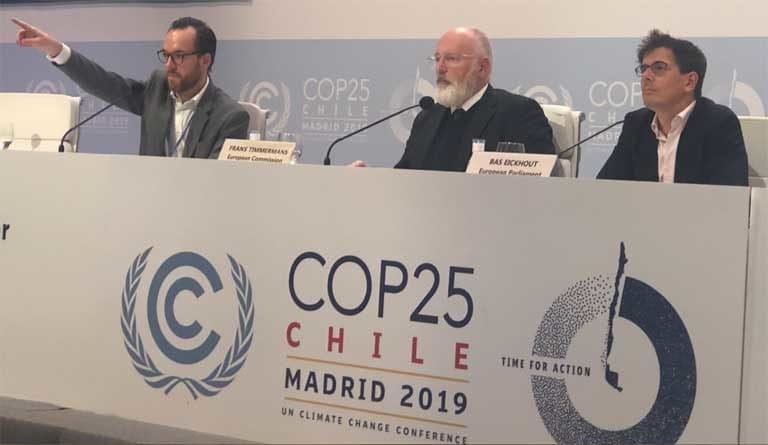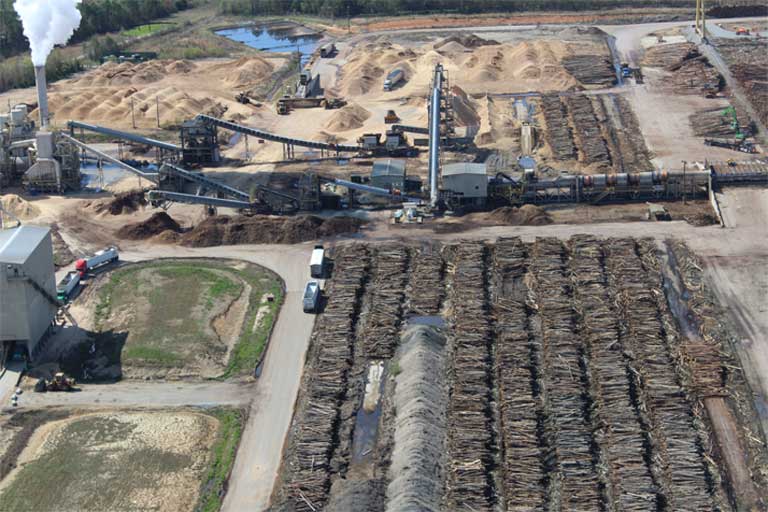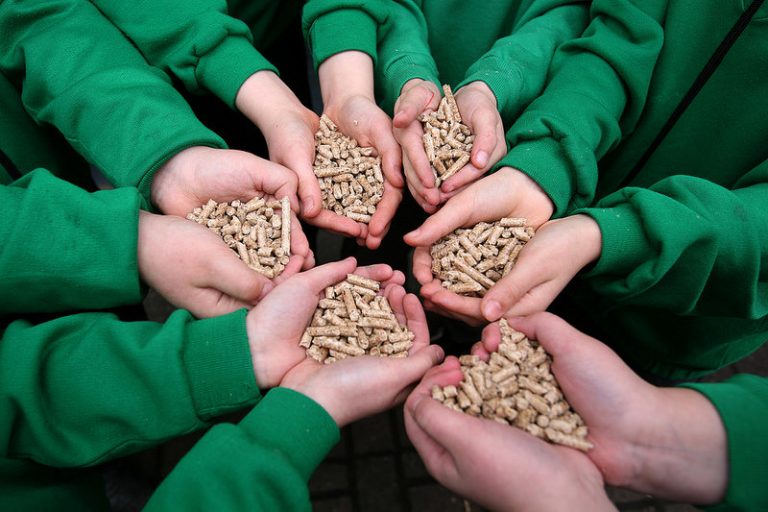- At a COP25 climate summit press conference on Thursday, December 12, Frans Timmermans, executive vice president of the EU and a Dutch politician answered a Mongabay question concerning the UN biomass carbon accounting loophole.
- When asked if the EU would close the loophole, he said: “The issue of biofuels needs to be looked at very carefully. We have to make sure that what we do with biofuels is sustainable and does not do more harm than that it does good.” A second EU official expressed a similar view. The issue won’t likely be reviewed until after 2020.
- This is perhaps the first acknowledgement by a top developed world official that the biomass loophole is a potential problem. The loophole encourages power plants that burn coal (whose carbon emissions are counted) to be converted to biomass — the burning of wood pellets (whose carbon emissions are counted as carbon neutral).
- Recent science shows that burning wood pellets is worse than burning coal, since more pellets must be burned to produce equivalent energy levels to coal. Also replacing plantation forests to achieve carbon neutrality takes many decades, time not available to a world that needs to quickly cut emissions over the next 20 years.

MADRID, Spain – Two high-level members of the European Union delegation announced that the carbon neutrality designation given to biomass energy — replacing coal with wood pellets — will come under critical review by the EU as a result of current science showing that biomass burning produces significant amounts of carbon emissions.
The unexpected announcement came during a press conference Thursday, December 12, at the 25th United Nations climate summit (COP25).
“The issue of biofuels needs to be looked at very carefully,” said Frans Timmermans, executive vice president of the EU and a Dutch politician, in response to a question from Mongabay. “We have to make sure that what we do with biofuels is sustainable and does not do more harm than that it does good.”
Timmermans’ view is significant because the conversion of coal-fired power plants to the burning of wood pellets is one of the fastest-growing energy sources in the United Kingdom and EU. Because trees can be replanted, wood pellets have been classified as renewable energy on par with carbon-zero wind and solar energy by the UN for more than twenty years.
Thus, countries making the coal-to-biomass transition can zero out their emissions on paper, even as a decades’ worth of research demonstrates that biomass generates more emissions at the smokestack than burning coal. Meanwhile, acres of carbon-absorbing trees are being cut down to be pelletized, devastating biodiversity in the U.S. Southeast and a growing number of forest nations, in what has become a multibillion-dollar global industry.
Timmermans added: “I know the science has evolved on this issue [of carbon neutrality] hugely in the last couple of years. We have to make sure that we use the latest scientific evidence in order to do the right thing.”

Bas Eickhout, a member of the European Union Parliament from the Netherlands, said during the press conference: “The previous time we did a review of our Renewable Energy Directive (RED) a few years ago, we had a long, extensive discussion about the sustainability criteria on the use of biomass for renewables. Speaking only for myself, I would have loved to see a stronger criteria in place.”
Critics of biomass-for-energy say the EU’s 2018-approved Renewable Energy Directive — which obligates member nations to generate at least 32 percent of their energy from renewable sources by 2030 — has generated a surge in demand for wood pellets, with nations capitalizing on the UN biomass carbon neutrality loophole, and shifting investment that could have gone to wind and solar.
Proponents of biomass for energy contend that well managed forests (the forestry industry term for tree farms or tree plantations) promote healthier forests, with newly planted trees absorbing more carbon as they grow compared to mature forests. That view was common among policymakers and forestry experts 20 years ago and at first went largely unchallenged. That’s no longer the case.

EU scientists speak out
Significantly, the European Academies’ Science Advisory Council (EASAC) released a series of reports before and near the end of the COP25 climate summit that intensified its criticism of biomass-for-energy and the carbon neutrality loophole.
“The concept of the carbon neutrality of forest biomass may have had some validity in 2009 when the urgency of tackling global warming was less widely recognized and the idea was simply that growing biomass removes as much CO2 from the atmosphere as is emitted from its combustion,” said Michael Norton, EASAC’s program director in a statement.
“But the focus today is on limiting global warming to 1.5 or 2 degrees Celsius,” he added. “This requires urgent actions, not waiting for new trees to grow while pumping additional carbon into the atmosphere by burning trees for energy.”
Altering the EU’s Renewable Energy Directive — if it does indeed come about — could reverse the demand for wood pellets across Europe and the United Kingdom, said Gry Bossen, a policy coordinator with Forests of the World in Copenhagen, an NGO.
Denmark now gets about 30 percent of its energy from wood pellets, but, utilizing the loophole, reports none of the resulting carbon emissions. The UK and Belgium are also heavy users of wood pellets for energy.
“I’m actually surprised to hear what the EU representatives had to say,” Bossen said. “This is new information for us, and really encouraging that the EU wants to look at the science.”
The review is not going to come right away, Eikhout said. First, the EU needs to determine its increased carbon-reduction ambition under the Paris Agreement, a process that will take much of next year. A review of RED could come in 2021 or 2022, he said.

Considering the long-standing UN biomass carbon neutrality policy, along with the lucrative fast growing wood pellet industry, the EU’s altering of the designation is certain to face fierce opposition. The forestry industry, which has seen an increase in logging as a result of international wood pellet demand, will very likely oppose changes to RED.
But Kelsey Perlman, a forest and climate campaigner with Fern, an environmental advocacy group based in Brussels, noted that the new European Green Deal released by the EU during COP25 contains a “green oath, in which policies that didn’t work in the past will be rectified in the future.”
“It’s good to have politicians saying publicly that they are going to address this issue of carbon neutrality and biomass,” Perlman said. “It’s long overdue.”
Justin Catanoso, a professor of journalism at Wake Forest University in North Carolina, covers climate change and climate policy for Mongabay; this is his sixth UN climate summit. Follow him on Twitter @jcatanoso
Banner image caption: A managed U.S. red pine plantation. Image by Nicholas Tonelli under the Creative Commons CC0 1.0 Universal Public Domain Dedication.
FEEDBACK: Use this form to send a message to the author of this post. If you want to post a public comment, you can do that at the bottom of the page.
